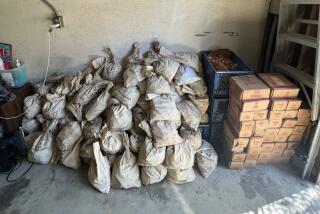Couple Likes to Take Wooden Nickels
- Share via
ELKTON, Md. — Walter and Mayme Scott don’t buy the old maxim, “Don’t take any wooden nickels.” In fact, they’ll take all the wooden nickels they can get.
The Scotts--she’s 60; he’s 67 and a retired auto worker--own a small fortune in the bogus currency. Scott estimates that he has about 25,000 wooden nickels. They’re kept in about 50 loose-leaf binders, each book bulging with 25 to 30 pages of coin-filled plastic pockets.
There’s enough, Scott jokingly guesses, “to float a battleship.”
The Scotts, who live in this small town in northeastern Maryland’s Cecil County, found their hobby doing another collector a favor. In 1974 a friend asked Scott to deliver the man’s special wooden nickel collection to an exhibit in Shippensburg, Pa.
Soon Scott had his own 273-piece collection commemorating the county’s 300th anniversary.
Now the Scotts own buckets of wooden nickels issued by chain restaurants including McDonald’s, Dairy Queen and Hardee’s. Some were worth real money, such as the one that reads: “Good for 25 cents with next purchase at any White Coffee Pot Jr.,” a Baltimore fast-food chain.
They own handfuls of Canadian spruce dollars--relatively rare oversized wooden nickels made from spruce trees that fetch $5 and more on the collectors’ market.
Their riches also include wooden nickels from the now-defunct Sambo’s restaurant chain, which mulched nickels left over when it went out of business. Collectors have paid up to $18 for those hard-to-find Sambo’s nickels.
The Scotts, who also collect wooden Christmas cards and wooden postcards, say their collection is virtually worthless. But they add that a wooden nickel without monetary value printed on it isn’t worth, well, a wooden nickel.
“It has to have a monetary value (printed on it) or it’s not a wooden nickel,” Scott said. “It’s a wooden token.”
And they know their wood coinage.
Both Scotts are past presidents of the International Organization of Wooden Money Collectors, founded in 1964. Scott is also in his 10th year as editor of the club’s official newsletter, Bunyan’s Chips.
The newsletter goes to about 350 of the club’s 375 members, Scott said, including two in Puerto Rico and a couple of servicemen in Germany.
Based on the fluctuating membership, Scott estimates that at least 2,000 people in America collect wooden nickels.
“A lot of them are seniors who need friendship. A lot of them are people who love to get anything in the mail to communicate,” he said.
“We (collect), because it’s a hobby,” said Mayme Scott. “We just like doing it. We like the friendships we make.”
According to the Macmillan Encyclopedic Dictionary of Numismatics, the first wooden money in America was ersatz dollars made for the unlucky depositors of the Citizens Bank of Tenino, Wash., when the bank failed in the 1930s. Customers were supposed to use the wooden money as cash.
Noting that wood imitations of paper money were made in Austria in 1920, and that Canada and other countries have occasionally struck wooden currency, the dictionary defined wood money as still “considered distinctly an American contribution to exonumia”--objects that resemble money but are not legal tender.
Albert Bonesio, 72, of Torrington, Conn., first vice president of the International Organization of Wooden Money Collectors, has collected wooden nickels for 30 years. He’s also president of a spinoff group, Dedicated Wooden Nickels.
A collection’s value just depends, Scott said.
“What do you want to pay for it? What’s it worth to you? That’s the bottom line. What’s it worth to you?”
More to Read
Sign up for Essential California
The most important California stories and recommendations in your inbox every morning.
You may occasionally receive promotional content from the Los Angeles Times.











